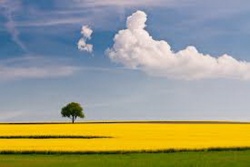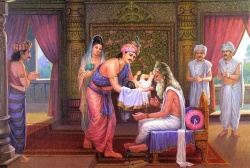Mahayana sutras
Mahāyāna sutras are a broad genre of Buddhist scriptures that various traditions of Mahāyāna Buddhism accept as canonical. They are largely preserved in the Chinese Buddhist canon, the Tibetan Buddhist canon, and in extant Sanskrit manuscripts. Around one hundred Mahāyāna sutras survive in Sanskrit, or in Chinese and Tibetan translations.
History and background
Origins and early history
The Mahayana sutras are a very broad genre of Buddhist scriptures that the Mahayana Buddhist tradition holds are original teachings of the Buddha. Some adherents of Mahayana accept both the early teachings (including in this the Sarvastivada Abhidharma, which was criticized by Nagarjuna and is in fact opposed to early Buddhist thought) and the Mahayana sutras as authentic teachings of Gautama Buddha, and claim they were designed for different types of persons and different levels of spiritual understanding.
The Mahayana sutras often claim to articulate the Buddha's deeper, more advanced doctrines, reserved for those who follow the bodhisattva path. That path is explained as being built upon the motivation to liberate all living beings from unhappiness. Hence the name Mahāyāna (lit., the Great Vehicle).
According to Mahayana tradition, the Mahayana sutras were transmitted in secret, came from other Buddhas or Bodhisattvas, or were preserved in non-human worlds because human beings at the time could not understand them:
- Some of our sources maintain the authenticity of certain other texts not found in the canons of these schools (the early schools). These texts are those held genuine by the later school, not one of the eighteen, which arrogated to itself the title of Mahayana, 'Great Vehicle'. According to the Mahayana historians these texts were admittedly unknown to the early schools of Buddhists. However, they had all been promulgated by the Buddha. [The Buddha's] followers on earth, the sravakas ('pupils'), had not been sufficiently advanced to understand them, and hence were not given them to remember, but they were taught to various supernatural beings and then preserved in such places as the Dragon World.
Approximately six hundred Mahayana sutras have survived in Sanskrit or in Chinese or Tibetan translations. In addition, East Asian Buddhism recognizes some sutras regarded by scholars as of Chinese rather than Indian origin.
Generally, scholars conclude that the Mahayana scriptures were composed from the 1st century CE onwards: "Large numbers of Mahayana sutras were being composed in the period between the beginning of the common era and the fifth century", five centuries after the historical Gautama Buddha. Some of these had their roots in other scriptures composed in the 1st century BCE. It was not until after the 5th century CE that the Mahayana sutras started to influence the behavior of mainstream Buddhists in India: "But outside of texts, at least in India, at exactly the same period, very different—in fact seemingly older—ideas and aspirations appear to be motivating actual behavior, and old and established Hinnayana groups appear to be the only ones that are patronized and supported." These texts were apparently not universally accepted among Indian Buddhists when they appeared; the pejorative label hinayana was applied by Mahayana supporters to those who rejected the Mahayana sutras.
Only the Theravada school does not include the Mahayana scriptures in its canon. As the modern Theravada school is descended from a branch of Buddhism that diverged and established itself in Sri Lanka prior to the emergence of the Mahayana texts, debate exists as to whether the Theravada were historically included in the hinayana designation; in the modern era, this label is seen as derogatory, and is generally avoided.
Scholar Isabelle Onians asserts that although "the Mahāyāna ... very occasionally referred contemptuously to earlier Buddhism as the Hinayāna, the Inferior Way," "the preponderance of this name in the secondary literature is far out of proportion to occurrences in the Indian texts." She notes that the term Śrāvakayāna was "the more politically correct and much more usual" term used by Mahāyānists. Jonathan Silk has argued that the term "Hinayana" was used to refer to whomever one wanted to criticize on any given occasion, and did not refer to any definite grouping of Buddhists.
The origins of Mahāyāna are not completely understood. The earliest views of Mahāyāna Buddhism in the West assumed that it existed as a separate school in competition with the so-called "Hīnayāna" schools. Due to the veneration of buddhas and bodhisattvas, Mahāyāna was often interpreted as a more devotional, lay-inspired form of Buddhism, with supposed origins in stūpa veneration,or by making parallels with the history of the European Protestant Reformation. These views have been largely dismissed in modern times in light of a much broader range of early texts that are now available. These earliest Mahāyāna texts often depict strict adherence to the path of a bodhisattva, and engagement in the ascetic ideal of a monastic life in the wilderness, akin to the ideas expressed in the Rhinoceros Sūtra. The old views of Mahāyāna as a separate lay-inspired and devotional sect are now largely dismissed as misguided and wrong on all counts.
The earliest textual evidence of "Mahāyāna" comes from sūtras originating around the beginning of the common era. Jan Nattier has noted that in some of the earliest Mahāyāna texts such as the Ugraparipṛccha Sūtra use the term "Mahāyāna", yet there is no doctrinal difference between Mahāyāna in this context and the early schools, and that "Mahāyāna" referred rather to the rigorous emulation of Gautama Buddha in the path of a bodhisattva seeking to become a fully enlightened buddha.
There is also no evidence that Mahāyāna ever referred to a separate formal school or sect of Buddhism, but rather that it existed as a certain set of ideals, and later doctrines, for bodhisattvas.Paul Williams has also noted that the Mahāyāna never had nor ever attempted to have a separate Vinaya or ordination lineage from the early schools of Buddhism, and therefore each bhikṣu or bhikṣuṇī adhering to the Mahāyāna formally belonged to an early school. This continues today with the Dharmaguptaka ordination lineage in East Asia, and the Mūlasarvāstivāda ordination lineage in Tibetan Buddhism. Therefore Mahāyāna was never a separate rival sect of the early schools.
The Chinese monk Yijing who visited India in the 7th century CE, distinguishes Mahāyāna from Hīnayāna as follows:
- “Both adopt one and the same Vinaya, and they have in common the prohibitions of the five offences, and also the practice of the Four Noble Truths. Those who venerate the bodhisattvas and read the Mahayana sūtras are called the Mahāyānists, while those who do not perform these are called the Hīnayānists.”
Much of the early extant evidence for the origins of Mahāyāna comes from early Chinese translations of Mahāyāna texts. These Mahāyāna teachings were first propagated into China by Lokakṣema, the first translator of Mahāyāna sūtras into Chinese during the 2nd century CE.
Scholarly views on historicity
Some scholars take an agnostic view and consider the Mahāyāna sutras as an anonymous literature, since it can not be determined by whom they were written, and only can be dated firmly to the date when they were translated into another language. Others such as A. K. Warder have argued that the Mahāyāna sutras are not historical. Andrew Skilton summarizes a common prevailing view of the Mahāyāna sutras:
- “These texts are considered by Mahāyāna tradition to be buddhavacana, and therefore the legitimate word of the historical Buddha. The śrāvaka tradition, according to some Mahāyāna sutras themselves, rejected these texts as authentic buddhavacana, saying that they were merely inventions, the product of the religious imagination of the Mahāyānist monks who were their fellows. Western scholarship does not go so far as to impugn the religious authority of Mahāyāna sutras, but it tends to assume that they are not the literal word of the historical Śākyamuni Buddha. Unlike the śrāvaka critics just cited, we have no possibility of knowing just who composed and compiled these texts, and for us, removed from the time of their authors by up to two millenia, they are effectively an anonymous literature. It is widely accepted that Mahāyāna sutras constitute a body of literature that began to appear from as early as the 1st century BCE, although the evidence for this date is circumstantial. The concrete evidence for dating any part of this literature is to be found in dated Chinese translations, amongst which we find a body of ten Mahāyāna sutras translated by Lokaksema before 186 C.E. – and these constitute our earliest objectively dated Mahāyāna texts. This picture may be qualified by the analysis of very early manuscripts recently coming out of Afghanistan, but for the meantime this is speculation. In effect we have a vast body of anonymous but relatively coherent literature, of which individual items can only be dated firmly when they were translated into another language at a known date.”
John W. Pettit, while stating, "Mahayana has not got a strong historical claim for representing the explicit teachings of the historical Buddha", also argues that the basic concepts of Mahāyāna do occur in the Pāli canon and that this suggests that Mahāyāna is "not simply an accretion of fabricated doctrines" but "has a strong connection with the teachings of Buddha himself".
It should be noted that however weak claim to historicity that the Mahāyāna sutras hold, this does not mean that all scholars believe that the Pāli Canon is historical; some scholars believe that it is not.
Still others such as D.T. Suzuki have stated that it doesn't matter if the Mahāyāna sutras can be historically linked to the Buddha or not, since Mahāyāna is a living tradition and its teachings are followed by millions of people.
Beliefs of Mahāyāna Buddhists
Some traditional accounts of the transmission of the Mahāyāna sutras claims that many parts were actually written down at the time of the Buddha and stored for five hundred years in the realm of the nāgas (serpent-like supernatural beings who dwell in another plane of being). The reason given for the late disclosure of the Mahāyāna teachings is that most people were initially unable to understand the Mahāyāna sutras at the time of the Buddha (500 BCE) and suitable recipients for these teachings had still to arise amongst humankind.
According to Venerable Hsuan Hua from the tradition of Chinese Buddhism, there are five types of beings who may speak the sutras of Buddhism: a buddha, a disciple of a buddha, a deva, a ṛṣi, or an emanation of one of these beings; however, they must first receive certification from a buddha that its contents are true Dharma. Then these sutras may be properly regarded as the words of the Buddha (Skt. buddhavacana).
Some teachers take the view that all teachings that stem from the fundamental insights of Buddha constitute the Buddha's speech, whether they are explicitly the historical words of the Buddha or not. There are scriptural supports for this perspective even in the Pāli Canon. There the Buddha is asked how the disciples should verify, after his death, which of the teachings circulating are his. In the Mahaparinibbana Sutta (DN 16) the Buddha is quoted as saying:
- “There is the case where a bhikkhu says this: 'In the Blessed One's presence have I heard this, in the Blessed One's presence have I received this: This is the Dhamma, this is the Vinaya, this is the Teacher's instruction.' His statement is neither to be approved nor scorned. Without approval or scorn, take careful note of his words and make them stand against the Suttas (discourses) and tally them against the Vinaya (monastic rules). If, on making them stand against the Suttas and tallying them against the Vinaya, you find that they don't stand with the Suttas or tally with the Vinaya, you may conclude: 'This is not the word of the Blessed One; this bhikkhu has misunderstood it' — and you should reject it. But if... they stand with the Suttas and tally with the Vinaya, you may conclude: 'This is the word of the Blessed One; this bhikkhu has understood it rightly.'"”
Earliest extant Mahāyāna sūtras
Some scholars have traditionally considered the earliest Mahāyāna sūtras to include the very first versions of the Prajñāpāramitā series, along with texts concerning Akṣobhya Buddha, which were probably composed in the 1st century BCE in the south of India. Some early Mahāyāna sūtras were translated by the Kuṣāṇa monk Lokakṣema, who came to China from the kingdom of Gandhāra. His first translations to Chinese were made in the Chinese capital of Luoyang between 178 and 189 CE. Some Mahāyāna sūtras translated during the 2nd century CE include the following:
- Aṣṭasāhasrikā Prajñāpāramitā Sūtra
- Larger Sukhāvatīvyūha Sūtra
- Akṣobhyatathāgatasyavyūha Sūtra
- Ugraparipṛccha Sūtra
- Mañjuśrīparipṛcchā Sūtra
- Drumakinnararājaparipṛcchā Sūtra
- Śūraṅgama Samādhi Sūtra
- Bhadrapāla Sūtra
- Ajātaśatrukaukṛtyavinodana Sūtra
- Kāśyapaparivarta Sūtra
- Lokānuvartana Sūtra
- An early sūtra connected to the Avataṃsaka Sūtra
Some of these were probably composed in the north of India in the 1st century CE. hus scholars generally think that the earliest Mahāyāna sūtras were mainly composed in the south of India, and later the activity of writing additional scriptures was continued in the north. However, the assumption that the presence of an evolving body of Mahāyāna scriptures implies the contemporaneous existence of distinct religious movement called Mahāyāna, which may be wrong.
Nature of the Mahāyāna sutras
The teachings as contained in the Mahāyāna sutras as a whole have been described as a loosely bound bundle of many teachings, which was able to contain the various contradictions between the varying teachings it comprises. Because of these contradictory elements, there are "very few things that can be said with certainty about Mahayana Buddhism".
Collections of Mahāyāna sutras
The Mahāyāna sutras survive predominantly in primary translations in Chinese and Tibetan from original texts in Buddhist Hybrid Sanskrit or various prakrits.
Mahāyāna canon
Although there is no definitive Mahāyāna canon as such, the printed or manuscript collections in Chinese and Tibetan, published through the ages, have preserved the majority of known Mahāyāna sutras. Many parallel translations of certain sutras exist. A handful of them, such as the Prajñāpāramitā sutras like the Heart Sutra and the Diamond Sutra, are considered fundamental by most Mahāyāna traditions.
The standard modern edition of the Buddhist Chinese canon is the Taisho Tripitaka, redacted during the 1920s in Japan, consisting of eighty-five volumes of writings that, in addition to numerous Mahāyāna texts, both canonical and not, also include Āgama collections, several versions of the vinaya, abhidharma and tantric writings. The first thirty-two volumes contain works of Indic origin, volumes thirty-three to fifty-five contain works of native Chinese origin and volumes fifty-six to eighty-four contain works of Japanese composition. The eighty-fifth volume contains miscellaneous items including works found at Dunhuang. A number of apocryphal sutras composed in China are also included in the Chinese Buddhist canon, although the spurious nature of many more was recognized, thus preventing their inclusion in the canon. The Sanskrit originals of many Mahāyāna texts have not survived to this day, although Sanskrit versions of the majority of the major Mahāyāna sutras have survived.
Brief descriptions of some sutras
Proto-Mahāyāna sutras
Early in the 20th century, a cache of texts was found in a mound near Gilgit in Pakistan. Amongst them was the Ajitasena Sūtra. This sutra appears to be a mixture of Mahāyāna and pre-Mahāyāna ideas. The text is set in a world where monasticism is the norm, typical of the Pāli Suttas; there is none of the usual antagonism towards the śravakas (i.e., the early Buddhists) or the notion of Arahantship, as is typical of Mahāyāna sutras such as the Vimalakīrti-nirdeśa Sūtra. However, the Ajitasena Sūtra also depicts an Arahant seeing all the Buddha fields, and it is said that reciting the name of the sutra saves beings from suffering and from the hell realms, and a meditative practice is described as allowing one to see with the eyes of a Buddha and receive teachings from Buddhas. These qualities are more typical of Mahāyāna sutras.
Samādhi sutras
Amongst the earliest Mahāyāna texts, the samādhi sutras are a collection of sutras that focus on the attainment of profound states of consciousness reached in meditation, perhaps suggesting that meditation played an important role in early Mahāyāna. These include the Pratyutpanna-sūtra, Samādhirāja-sūtra and Śūraṅgama-samādhi-sūtra.
Perfection of Wisdom texts
Sanskrit manuscript of the Heart Sūtra in the Siddhaṃ script. Bibliothèque nationale de France
These deal with Buddhist wisdom (prajñā). "Wisdom" in this context means the ability to see reality as it truly is. They do not contain an elaborate philosophical argument, but simply try to point to the true nature of reality, especially through the use of paradox. The basic premise is a radical non-dualism, in which every and any dichotomist way of seeing things is denied: so phenomena are neither existent, nor non-existent, but are marked by emptiness (śūnyatā), an absence of any essential, unchanging nature. The Perfection of Wisdom in One Letter illustrates this approach by choosing to represent the perfection of wisdom with the Sanskrit and Pāli short a or "schwa" vowel ("अ", [ə]). As a prefix, this negates a word's meaning, e.g., changing "svabhāva", "with essence" to "asvabhāva", "without essence". It is the first letter of Indic alphabets and, as a sound on its own, can be seen as the most neutral and basic of speech sounds. Many sutras are known by the number of lines, or ślokas, that they contain.
Edward Conze, who translated all of the Perfection of Wisdom sutras into English, identified four periods of development in this literature:
- 100 BCE – 100 CE: Ratnaguṇasamcayagatha and the Aṣṭasāhasrikā (8,000 lines)
- 100–300 CE: a period of elaboration in which versions in 18,000, 25,000 and 100,000 lines are produced. Possibly the Diamond Sutra too stems from this period.
- 300–500 CE: a period of condensation, producing the well known Heart Sutra and the Perfection of Wisdom in One Letter.
- 500–1000 CE: Texts from this period begin to show a tantric influence.
The Perfection of Wisdom texts have influenced every Mahāyāna school of Buddhism.
Saddharma Puṇḍarīka
This sutra is called the Lotus Sutra, White Lotus Sutra, Sutra of the White Lotus or Sutra on the White Lotus of the Sublime Dharma; Sanskrit: Saddharma-pundarīka-sūtra; 妙法蓮華經 Cn: Miàofǎ Liánhuā Jīng; Jp: Myōhō Renge Kyō. Probably written down in the period 100 BCE – 100 CE, the White Lotus Sutra proposes that the three yānas (śravakayāna, pratyekabuddhayāna and bodhisattvayāna) are not in fact three different paths leading to three goals, but one path, with one goal. The earlier teachings are said to be skilful means to help beings of limited capacities. The sutra is notable for the (re)appearance of the Buddha Prabhutaratna, who had died several aeons earlier, because it suggests that a Buddha is not inaccessible after his parinirvāṇa and also that his life-span is said to be inconceivably long because of the accumulation of merit in past lives. This idea, though not necessarily from this source, forms the basis of the later doctrine of the three bodies (trikāya). Later it became associated particularly with the Tien Tai school in China (Tendai in Japan) and the Nichiren schools in Japan.
The Ananta-nirdesa Sutra belongs to the Lotus Sutra category as well, and is also known as the Innumerable Meanings Sutra. This text was translated from Sanskrit into Chinese by Dharmajātayaśas, an Indian monk of the 4th to 5th century. It belongs to the so-called Threefold Lotus Sutra that is also composed of the Lotus Sutra and the Sutra of Meditation on the Bodhisattva Universal Virtue. It was and is considered to be the prologue to the Lotus Sutra itself, and is therefore included into the canon of some Nichiren Buddhist sects, and also Risshō Kōsei Kai.
Also in the Lotus Sutra category is the Samantabhadra Meditation Sutra, which is also called the Sutra of Meditation on the Bodhisattva Universal Virtue. This Mahayana Buddhist text teaches meditation and repentance practices. It is considered by many Mahayana sects to be a continuation (an epilogue) of the Buddha's teachings found within the Lotus Sutra and is therefore included into the canon of some Nichiren Buddhist sects, and also Risshō Kōsei Kai. The Bodhisattva Samantabhadra (Universal Virtue) is portrayed in the 28th chapter of the Lotus Sutra as the protector of the Dharma teachings from every kind of persecution.
Pure Land sutras
Book open to the Shorter Sukhāvatīvyūha Sūtra
The Pure Land teachings were first developed in India, and were very popular in Kashmir and Central Asia, where they may have originated. Pure Land sūtras were brought from the Gandhāra region to China as early as 147 CE, when the Kushan monk Lokakṣema began translating the first Buddhist sūtras into Chinese. The earliest of these translations show evidence of having been translated from the Gāndhārī language, a prakrit descended from Vedic Sanskrit, which was used in Northwest India.
The Pure Land sūtras are principally the Shorter Sukhāvatīvyūha Sūtra, Longer Sukhāvatīvyūha Sūtra, and the Amitāyurdhyāna Sūtra. The shorter sūtra is also known as the Amitābha Sūtra, and the longer sūtra is also known as the Infinite Life Sūtra. These sutras describe Amitābha and his Pure Land of Bliss, called Sukhāvatī. Also related to the Pure Land tradition is the Pratyutpanna Samādhi Sūtra, which describes the practice of reciting the name of Amitābha Buddha as a meditation method. In addition to these, many other Mahāyāna texts also feature Amitābha Buddha, and a total of 290 such works have been identified in the Taishō Tripiṭaka.
Pure Land texts describe the origins and nature of the Western Pure Land in which the Buddha Amitabha resides. They list the forty-eight vows made by Amitabha as a bodhisattva by which he undertook to build a Pure Land where beings are able to practise the Dharma without difficulty or distraction. The sutras state that beings can be reborn there by pure conduct and by practices such as thinking continuously of Amitabha, praising him, recounting his virtues, and chanting his name. These Pure Land sutras and the practices they recommend became the foundations of Pure Land Buddhism, which focus on the salvific power of faith in the vows of Amitabha. The Vimalakīrti Nirdeśa Sūtra
In this sutra, composed some time before 150 CE, the bodhisattva Vimalakīrti appears as a layman to teach the Dharma. This is seen by some as a strong assertion of the value of lay practice. Doctrinally similar to the Perfection of Wisdom texts, another major theme is the Buddhafield (Buddha-kṣetra), which was influential on Pure Land schools. This sutra has been very popular in China and Japan where it has been seen as being compatible with Confucian values.
Confession Sutras
The Triskandha Sūtra and the Golden Light Sutra (Suvarṇaprabhāsa-sūtra) focus on the practice of confession of faults. The Golden Light Sutra became especially influential in Japan, where its chapter on the universal sovereign was used by Japanese emperors to legitimise their rule and it provided a model for a well-run state.
The Avataṃsaka Sutra
This is large composite text consisting of several parts, most notably the Daśabhūmika Sutra and the Gandavyuha Sutra. It probably reached its current form by about the 4th century CE, although parts of it, such as those mentioned above, are thought to date from the 1st or 2nd century CE. The Gandavyuha Sutra is thought to be the source of a cult of Vairocana that later gave rise to the Mahāvairocana-abhisaṃbodhi tantra, which in turn became one of two central texts in Shingon Buddhism and is included in the Tibetan canon as a carya class tantra. The Avataṃsaka Sutra became the central text for the Hua-yen (Jp. Kegon) school of Buddhism, the most important doctrine of which is the interpenetration of all phenomena. Page from the Laṅkāvatāra Sūtra in Sanskrit
Third turning sutras
These sutras primarily teach the doctrine of Representation Only (vijñapti-mātra), associated with the Yogācāra school. The Sandhinirmocana Sutra (c 2nd century CE) is the earliest surviving sutra in this class. It divides the teachings of the Buddha into three types, which it calls the "three turnings of the wheel of the Dharma." To the first turning, it ascribes the Āgamas of the śravakas, to the second turning the lower Mahāyāna sutras including the Prajñā-pāramitā sutras, and finally sutras like itself are deemed to comprise the third turning. Moreover, the first two turnings are considered to be provisional in this system of classification, while the third group is said to present the final truth without a need for further explication (nītārtha). The well-known Laṅkāvatāra Sūtra, composed sometime around the 4th century CE, is sometimes included in this group, although it is somewhat syncretic in nature, combining pure Yogācāra doctrines with those of the tathāgatagarbha system and was unknown or ignored by the progenitors of the Yogācāra system. The Laṅkāvatāra Sūtra was influential in the Chan or Zen schools.
Tathāgatagarbha class sutras
These are especially the Tathāgatagarbha Sūtra, the Śrīmālā Sūtra (Śrīmālādevi-simhanāda Sūtra) and the Mahāyāna Mahāparinirvāṇa Sūtra (which is very different in character from the Pāli Mahaparinibbana Sutta). These texts teach that every being has a "Buddha nature" (tathāgatagarbha: variously translated as "Buddha nature", "Buddha seed", "Buddha matrix", "Buddha essence" or "Buddha principle"). This aspect of every being is an indwelling potency or element that enables beings to be liberated. It constitutes one of the most important responses of Buddhism to the problem of immanence and transcendence. The Tathāgatagarbha doctrine has been very influential in east Asian Buddhism and the idea in one form or another can be found in most of its schools. The Buddha in these sutras insists that the doctrine of the Tathāgatagarbha is ultimate and definitive (nītārtha)—not in need of "interpretation"—and that it takes the Dharma to the next and final, clarifying step of the teachings on emptiness (śūnyatā).
Collected Sutras
These two large sutras are, again, actually collections of other sutras. The Mahāratnakūṭa Sūtra contains 49 individual works, and the Mahāsamnipāta-sūtra is a collection of 17 shorter works. Both seem to have been finalised by about the 5th century, although some parts of them are considerably older.
Esoteric Sūtras
Esoteric sūtras comprise an important category of works that are esoteric, in the sense that they are often devoted to a particular mantra or dhāraṇī. Well-known dhāraṇī texts include the Uṣṇīṣa Vijaya Dhāraṇī Sūtra and the Cundī Dhāraṇī Sūtra.
Transmigration sutras
A number of sutras focus on actions that lead to existence in the various spheres of existence, or expound the doctrine of the twelve links of dependent-origination (pratītyasamutpāda).
Discipline sutras
These focus on principles that guide the behaviour of bodhisattvas, and include the Kāshyapa-parivarta, the Bodhisattva-prātimokṣa Sutra, and the Brahmajāla Sutra. For left home persons, the The Bequeathed Teachings Sutra is a necessary manual that guides them through the life of cultivation.
Sutras devoted to individual figures
TA large number of sutras describe the nature and virtues of a particular Buddha or bodhisattva and their pure land, including Mañjusri, Kṣitigarbha, the Buddha Akṣobhya, and Bhaiṣajyaguru, also known as the Medicine Buddha.
Vaipūlya Sūtras devoted to all Tathāgatas
The most widely used (in liturgy) of these is the Bhadra-kalpika Sutra, available in various languages (Chinese, Tibetan, Mongolian, etc.) in variants that differ slightly as to the number of Tathāgatas enumerated. For example, the Khotanese version is the proponent of a 1005-Tathāgata system. There is in use in the Shingon school a sutra naming some 10,000 Tathāgatas, distinguishing the ones longer-lived after enlightenment (the same as in the approximately 1,000 in the Bhadra-kalpika) as "Sun-Buddhas", and the shorter-lived ones as "Moon-Buddhas".
